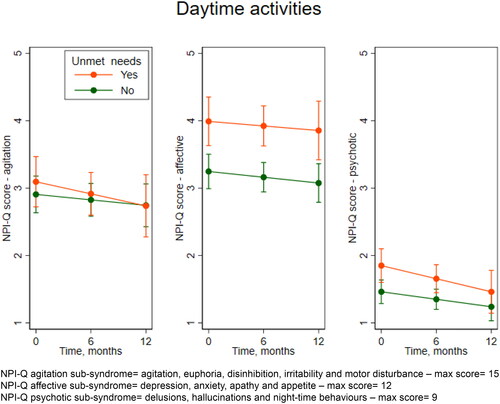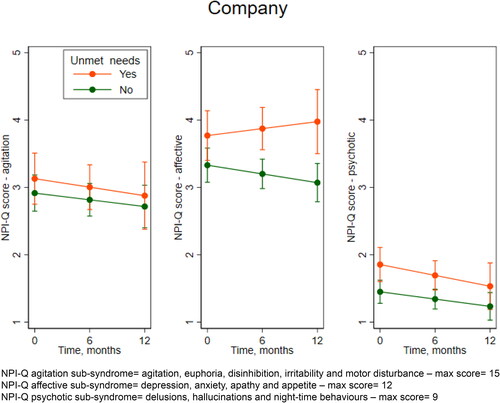Figures & data
Table 1. Principal component analysis of the Neuropsychiatric Inventory-Questionnaire (NPI-Q), Varimax rotation with Kaiser normalisation.
Table 2. Characteristics of the participants at baseline.
Table 3. Proportions of participants with clinically significant symptoms at baseline, per subsyndrome, classified as no/not significant symptoms – mild/moderate symptoms – severe symptoms, grouped by no/met need and unmet need for daytime activities and company.
Figure 1. Mean Neuropsychiatric Inventory-Questionnaire (NPI-Q) scores over time for those with no need/met needs for daytime activities versus those with unmet needs. Vertical lines are 95% confidence intervals. Estimated in mixed regression where needs was modelled as a time dependent covariate, adjusted by age, sex, living alone/with someone, region, diagnosis, education, Charlson Comorbidity Index, Clinical Dementia Rating and Instrumental Activities of Daily Living.
NPI-Q agitation sub-syndrome = agitation, euphoria, disinhibition, irritability and motor disturbance – max score = 15
NPI-Q affective sub-syndrome = depression, anxiety, apathy and appetite – max score = 12
NPI-Q psychotic sub-syndrome = delusions, hallucinations and night-time behaviours – max score = 9

Table 4. Mean difference in NPI-Q sub-syndromes between groups: no need/met need vs unmet need, concerning daytime activities and company.
Figure 2. Mean Neuropsychiatric Inventory-Questionnaire (NPI-Q) scores over time for those with no need/met needs for company versus those with unmet needs. Vertical lines are 95% confidence intervals. Estimated in mixed regression where needs was modelled as a time dependent covariate, adjusted by age, sex, living alone/with someone, region, diagnosis, education, Charlson Comorbidity Index, Clinical Dementia Rating and Instrumental Activities of Daily Living.
NPI-Q agitation sub-syndrome = agitation, euphoria, disinhibition, irritability and motor disturbance – max score = 15
NPI-Q affective sub-syndrome = depression, anxiety, apathy and appetite – max score = 12
NPI-Q psychotic sub-syndrome = delusions, hallucinations and night-time behaviours – max score = 9

